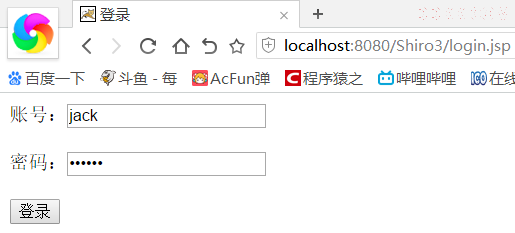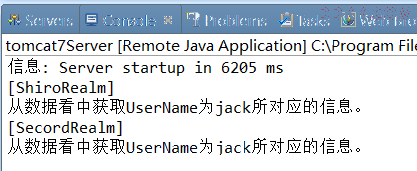13、Shiro 实战:SecurityManager配置realms
注:该系列所有测试均在之前创建的Shiro3的Web工程的基础上。大家可以注意到,在没有使用认证器之前,我们是这样配置Realm的:
<bean id="securityManager" class="org.apache.shiro.web.mgt.DefaultWebSecurityManager">
<property name="cacheManager" ref="cacheManager"/>
<property name="realm" ref="shiroRealm"/>
</bean>
<bean id="shiroRealm" class="com.test.shiro.realms.ShiroRealm"></bean>
后来使用了多Realm验证时,会将多个Realm配置到认证器中,再将认证器配置给securityManager:
<!--1. 配置 SecurityManager-->
<bean id="securityManager" class="org.apache.shiro.web.mgt.DefaultWebSecurityManager">
<property name="cacheManager" ref="cacheManager"/>
<property name="authenticator" ref="authenticator"/>
</bean>
<!-- 认证器 -->
<bean id="authenticator" class="org.apache.shiro.authc.pam.ModularRealmAuthenticator">
<property name="realms">
<list>
<ref bean="shiroRealm"/>
<ref bean="secordRealm"/>
</list>
</property>
<property name="authenticationStrategy">
<bean class="org.apache.shiro.authc.pam.AtLeastOneSuccessfulStrategy"></bean>
</property>
</bean>
那么,我们如果将authenticator中的realms删除,而重新在securityManager添加两个Realm配置,
我们的工程还能跑起来吗?可以试验一下,首先将配置改为一下配置:
<!--1. 配置 SecurityManager-->
<bean id="securityManager" class="org.apache.shiro.web.mgt.DefaultWebSecurityManager">
<property name="cacheManager" ref="cacheManager"/>
<property name="authenticator" ref="authenticator"/>
<property name="realms">
<list>
<ref bean="shiroRealm"/>
<ref bean="secordRealm"/>
</list>
</property>
</bean>
<!-- 认证器 -->
<bean id="authenticator" class="org.apache.shiro.authc.pam.ModularRealmAuthenticator">
<property name="authenticationStrategy">
<bean class="org.apache.shiro.authc.pam.AtLeastOneSuccessfulStrategy"></bean>
</property>
</bean>
重启Shiro3项目,然后使用jack登录:

发现依然可以进行正常的校验:

那么可以证明这种写法是没有问题的,但是我们要想一下,为什么这样可以呢?
可以看到,我们是在securityManager中配置了authenticator的,所以在进行校验的时候是通过authenticator来获取认证信息并且校验的(ModularRealmAuthenticator源码):

而使用的realms集合是authenticator类(ModularRealmAuthenticator)自己的realms属性,而我们在上面的配置中又没有给ModularRealmAuthenticator配置realms参数,而是给securityManager配置了realms属性,那么我们的程序是如何获取两个realm的认证信息的呢?
观察ModularRealmAuthenticator的源码我们可以看到,它除了包含名为realms的集合变量外,还有相应的get和set方法(当然这是IOC必须的),是不是有人在某个时候给它悄悄set了realms属性呢?
我们在AuthenticationSecurityManager中找到了答案:

发现在上面的方法中,只要校验出authenticator的类型属于ModularRealmAuthenticator,则会将SecurityManager的realms属性赋值给对应的authenticator类。所以确实是SecurityManager将自己的realms集合属性给了authenticator,所以authenticator才有realm可以用。
以后我们将使用这种写法来配置realm,因为后面我们讲解授权的时候,需要使用到SecurityManager的realms属性。